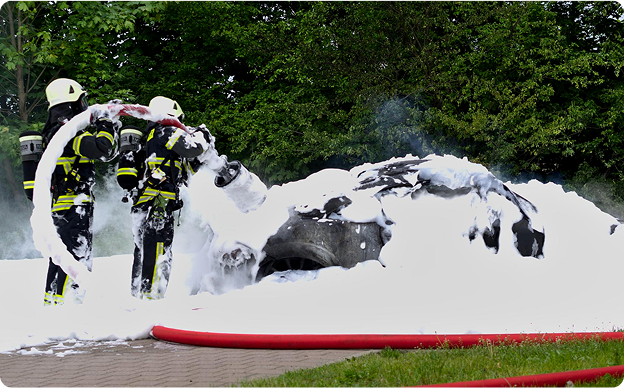Aqueous Film-Forming Foam (AFFF) is a firefighting foam used since the 1960s to combat flammable liquid fires. Many AFFF formulations contain per- and polyfluoroalkyl substances (PFAS), known as “forever chemicals” due to their persistence in the environment and accumulation in the human body.
This article highlights the concerns surrounding PFAS, focusing on their environmental contamination of water and soil. It also discusses AFFF-related lawsuits against manufacturers for failing to warn about significant health risks, such as cancer, particularly affecting firefighters, military personnel, and residents near bases or airports. The piece explains how these cases are managed through Multi-District Litigation (MDL) for efficiency and underscores the importance of pursuing these lawsuits to seek compensation and hold corporations accountable.
AFFF Lawsuit Explained: Understanding Firefighting Foam, PFAS Risks, and Your Legal Options
Aqueous Film-Forming Foam (AFFF), also known as Fire Fighting Foam, has been a critical tool in fire suppression, particularly for flammable liquid fires, since its development in the 1960s. However, the presence of “per- and polyfluoroalkyl substances (PFAS)” within AFFF formulations has raised significant environmental and health concerns, leading to widespread litigation.
At Outreach Legal, we understand the legal implications of AFFF exposure and are committed to helping those affected understand their rights.
Composition of AFFF
AFFF works by forming a thin, aqueous film that smothers flames and prevents reignition. This is achieved through a combination of surfactants, foam stabilizers, and, critically, PFAS. While the exact percentage of PFAS varies, it can be substantial in some formulations.
PFAS: The “Forever Chemicals” and Legal Ramifications
PFAS are valued for their resistance to water, oil, and heat, but their persistence in the environment and human body is a major concern. These “forever chemicals,” as designated by the United States Environmental Protection Agency (EPA), do not readily break down and can accumulate over time. This persistence leads to significant legal challenges regarding liability and compensation for those exposed.
Why Are PFAS a Concern?
- Environmental Persistence: PFAS contamination can persist for decades, leading to long-term environmental liability.
- Bioaccumulation: These chemicals accumulate in the food chain, posing health risks and potential legal claims.
- Water Contamination: Widespread detection of PFAS in drinking water sources, particularly near military bases, airports, and industrial sites, necessitates legal action to protect affected communities.
AFFF and Contamination Sites
- Military Bases: Extensive AFFF use in training and emergency responses has led to significant PFAS contamination.
- Airports: Both civilian and military airports have contributed to PFAS contamination through fire suppression activities.
- Industrial Facilities: Oil refineries, chemical plants, and fuel storage depots are also significant sources of PFAS contamination.
These sites represent potential grounds for legal claims related to environmental damage and personal injury.
Historical Use of AFFF and Legal Awareness
AFFF’s widespread use since the 1960s has only recently been met with increased scrutiny regarding its PFAS components. This delayed awareness underscores the importance of legal representation for those affected by historical exposure.
Understanding AFFF Litigation: What You Need to Know
Aqueous Film-Forming Foam (AFFF) has been widely used for decades to fight fires involving flammable liquids. However, this firefighting foam contains PFAS (per- and polyfluoroalkyl substances), which have been linked to serious health and environmental risks.
Many lawsuits have been filed against AFFF manufacturers, claiming they knew about these risks but failed to warn firefighters, military personnel, and communities about potential dangers. These legal actions aim to hold companies accountable and seek compensation for those affected.
Who is Affected by AFFF Exposure?
The people most likely to be impacted by AFFF exposure include:
- Firefighters: Both civilian and military firefighters who regularly used AFFF in training and emergencies.
- Military Personnel: Many bases used AFFF extensively, potentially exposing service members.
- Residents Near Military Bases & Airports: If you live near areas where AFFF was used, your water supply may be contaminated.
On the other side, the defendants in these cases are the companies that manufactured and sold AFFF over the years.
What’s Happening with AFFF Lawsuits?
AFFF lawsuits are being handled through Multi-District Litigation (MDL), a legal process that consolidates similar cases in one court to streamline pretrial proceedings. This means all lawsuits go through the same judge for motions, discovery (evidence gathering), and other pretrial steps, ensuring consistency across cases.
While some water contamination cases have reached settlements, individual injury claims are still moving through the legal system. If you believe you’ve been exposed, it’s important to stay informed about ongoing litigation.
How Does the Legal Process Work?
If you’re considering legal action, here’s a general breakdown of what to expect:
- Filing a Lawsuit: Individuals or groups file claims against AFFF manufacturers, detailing how exposure has affected them.
- Discovery Phase: Both sides gather and exchange evidence, conduct interviews (depositions), and review documents.
- MDL Proceedings (if applicable): If your case is part of the MDL, it will follow a structured process for pretrial motions and hearings.
- Settlement or Trial: Some cases may settle before reaching court, while others proceed to trial. A judge or jury will decide the outcome.
Why Does This Matter?
If you or someone you know has been exposed to AFFF, these lawsuits could provide a path to compensation for medical bills, lost wages, and other damages. More importantly, they bring attention to corporate accountability and environmental safety.
Frequently Asked Questions about the Firefighting Foam Lawsuit:
- Who qualifies for the lawsuit? You may qualify if you were exposed to AFFF foam through occupational use (such as being a firefighter or soldier) or if you lived near contaminated areas and developed a related health condition.
- What evidence do I need? You will need to provide medical records, proof of exposure (such as employment records or location history), and documentation of your health condition.
- How much compensation can I expect? The amount of compensation varies based on individual circumstances. Potential damages may include medical expenses, lost wages, pain and suffering, and punitive damages.
- Is there a deadline to join? It is important to contact us as soon as possible to ensure that you meet all necessary deadlines.
How to Stay Updated
AFFF litigation is ongoing, so staying informed is crucial. Reliable sources for updates include:
- The U.S. Courts Website – www.uscourts.gov (for MDL status and legal updates)
AFFF’s role in fire suppression is undeniable, but the environmental and health consequences of its PFAS content are significant. Understanding these concerns is crucial for pursuing legal action. If you think you’ve been exposed to AFFF and want to explore your legal options, consider speaking with an attorney who specializes in these cases.
Contact Outreach Legal to discuss your potential claim for FREE consultation
Frequently Asked Questions:
Who qualifies for the lawsuit?
You may qualify if you were exposed to AFFF foam through occupational use (such as being a firefighter or soldier) or if you lived near contaminated areas and developed a related health condition.
What evidence do I need?
You will need to provide medical records, proof of exposure (such as employment records or location history), and documentation of your health condition.
How much compensation can I expect?
The amount of compensation varies based on individual circumstances. Potential damages may include medical expenses, lost wages, pain and suffering, and punitive damages. If you have questions about potential AFFF exposure and your legal options, contact us for a free consultation: https://outreachlegal.com/lpg/lead-form/




